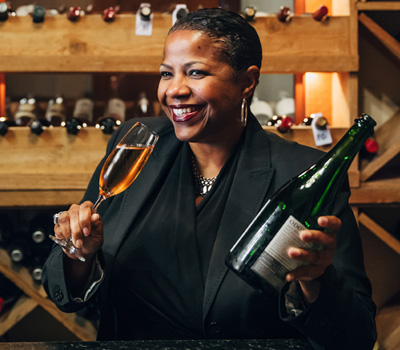For seven years, Tonya Pitts has been the wine director for the Lark Creek Restaurant Group, including SF’s One Market. That’s where she can usually be found, working the floor and running the city’s premier domestic-focused list. When she spoke to us this year she was busy dodging downtown Super Bowl traffic and revamping the restaurant for a week of private NFL events, including blind tasting sessions and blending seminars.


Defining Oregon pinot in California
If you want a pinot noir in a drier style, earthier and more terroir-driven, we tend to look toward Oregon. Sometimes guests will say, ‘I don’t like pinot noir from Oregon; it’s really dry, there’s not enough fruit.’ So you have to go into what that means: It’s just more akin to Burgundy and French pinot noir. You have different flavor profiles, but there’s still definitely fruit there. And if they don’t like it, I’ll take it away. That’s never an issue for me, because I can always use it that night by the glass or on the chef’s tasting menu, or I can even use the bottle for staff training.
Alt whites (Tatomer grüner and Dirty & Rowdy semillon in the top ten)
The majority of guests that walk in the door don’t know that our list is all domestic. They’re looking for French and Italian, and it’s not there unless it’s in the Somm’s Corner [the one part of the wine list that makes room for international selections]. So I try to seek out [European] varieties grown stateside that are varietally correct. For the longest time we worked with the Chehalem grüner, which is still on the wine list. If you want something more slatey and mineral-driven and racy, there’s the Tatomer.
The Dirty & Rowdy Semillon: I’ve been a huge Hardy [Wallace] fan for a really long time. Semillon, it’s another tough category to find. But it’s also something that’s great for food pairing on chef’s tasting menu. It’s my new alternative to viognier, because it’s not all oaked-out and perfumey. It’s a balanced wine.
On Well-Aged California Wines
We put in a Napa Technology machine—it’s a company out of Napa that has built these wine preservation panels. You can program the coolers to give whatever [size pour] you want. I decided to offer older vintages of wines. I’ve had the 2006 Grgich Hills cabernet, and I talked to Marty [Mathis] at Kathryn Kennedy, because I had seen a 1986 bottling that Lulu [McAllister of SF’s Nopa] had and I said: You got any of that floating around?
He sent me some wines to taste, and I bought the ’98, the 2000 and the 2004. The ’98 [Kathryn Kennedy Santa Cruz Mountains Cabernet] is available by bottle and by the glass. It’s great, because you give a guest an opportunity to taste older wines—lot of guests don’t have the option to see those by the glass. You can keep these wines under the argon, they’re saying, out of the cabinet and in storage for up to six months. But I’m going through the wine a lot faster than that, probably five or six bottle a week, if not more. I even had a 1989 Caymus Special Selection on there, at $75/glass. It lasted less than a week.
[Guests] think it’s really cool, and it also lets them know that they can age their wine. And domestic wines do age. Which is a huge question for a lot of people.
Best wine she drank this year
The 1981 Chalone “A Frame” Cabernet Sauvignon from Monterey. Deep, dark, black currant, blackberries, flinty, cocoa powder, pencil lead and so alive…. Now I’m on the hunt for older vintages of Chalone cabernet sauvignon and chardonnay. It’s kinda my unicorn wine.
Longtime senior editor at Wine & Spirits magazine, Luke now works for the Stanford Technology Ventures Program.
















